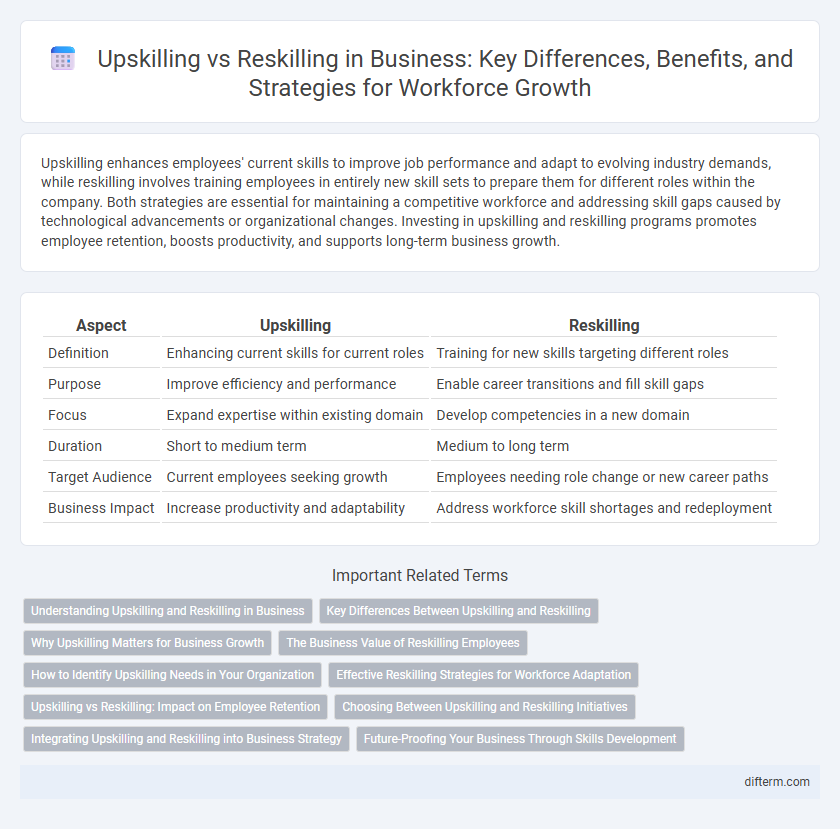Upskilling enhances employees' current skills to improve job performance and adapt to evolving industry demands, while reskilling involves training employees in entirely new skill sets to prepare them for different roles within the company. Both strategies are essential for maintaining a competitive workforce and addressing skill gaps caused by technological advancements or organizational changes. Investing in upskilling and reskilling programs promotes employee retention, boosts productivity, and supports long-term business growth.
Table of Comparison
| Aspect | Upskilling | Reskilling |
|---|---|---|
| Definition | Enhancing current skills for current roles | Training for new skills targeting different roles |
| Purpose | Improve efficiency and performance | Enable career transitions and fill skill gaps |
| Focus | Expand expertise within existing domain | Develop competencies in a new domain |
| Duration | Short to medium term | Medium to long term |
| Target Audience | Current employees seeking growth | Employees needing role change or new career paths |
| Business Impact | Increase productivity and adaptability | Address workforce skill shortages and redeployment |
Understanding Upskilling and Reskilling in Business
Upskilling involves enhancing existing employees' current skills to improve performance and adapt to evolving job requirements, while reskilling focuses on teaching employees entirely new skills to shift roles within the organization. Both strategies are critical in business for maintaining competitive advantage, driving innovation, and addressing skill gaps caused by technological advancements. Effective implementation of upskilling and reskilling programs reduces turnover costs and supports long-term workforce agility.
Key Differences Between Upskilling and Reskilling
Upskilling involves enhancing existing skills to improve current job performance, while reskilling focuses on training employees in entirely new skills to transition into different roles. Companies prioritize upskilling to boost productivity and maintain competitive advantage, whereas reskilling addresses workforce shifts due to technological advancements or market changes. Understanding these differences helps organizations allocate resources effectively for talent development and future-proofing their workforce.
Why Upskilling Matters for Business Growth
Upskilling enhances employee capabilities by developing advanced skills, directly boosting productivity and innovation essential for competitive advantage. Investing in upskilling reduces turnover costs and fosters a culture of continuous improvement, which supports sustainable business growth. Companies that prioritize upskilling align workforce expertise with evolving industry demands, driving long-term success.
The Business Value of Reskilling Employees
Reskilling employees enhances workforce agility by equipping staff with new skills tailored to evolving business demands, driving innovation and maintaining competitive advantage. It reduces recruitment costs and employee turnover by leveraging existing talent, fostering employee loyalty and job satisfaction. Companies investing in reskilling report increased productivity and improved ability to adapt to technological advancements and market changes.
How to Identify Upskilling Needs in Your Organization
Analyzing current employee skill gaps and aligning them with future business objectives is essential to identify upskilling needs in your organization. Conducting skills assessments combined with feedback from team leads provides data-driven insights into which competencies require enhancement. Leveraging performance metrics and industry trends further refines the focus on targeted skill development for sustained organizational growth.
Effective Reskilling Strategies for Workforce Adaptation
Effective reskilling strategies for workforce adaptation involve identifying critical skill gaps aligned with evolving industry demands and designing targeted training programs that foster hands-on learning and certification. Leveraging digital platforms and microlearning modules accelerates skill acquisition while promoting continuous development tailored to business goals. Employer investment in reskilling enhances employee retention, drives innovation, and ensures sustainable competitiveness in dynamic markets.
Upskilling vs Reskilling: Impact on Employee Retention
Upskilling enhances employee retention by improving current skills, boosting job satisfaction, and fostering career growth within the company; reskilling supports retention by enabling workforce adaptability to new business demands, reducing layoffs. Businesses investing in targeted upskilling programs report a 30% higher employee retention rate compared to those prioritizing reskilling alone. Balancing upskilling with strategic reskilling ensures a resilient workforce aligned with organizational goals, maximizing long-term retention and productivity.
Choosing Between Upskilling and Reskilling Initiatives
Choosing between upskilling and reskilling initiatives requires businesses to assess current workforce capabilities against future skill demands driven by technological advancements and market shifts. Upskilling enhances employees' existing skill sets to improve efficiency and innovation within their current roles, while reskilling prepares workers for entirely new positions to address skill gaps caused by organizational transformation. Strategic alignment with business goals and thorough workforce analytics ensure that talent development investments maximize employee productivity and organizational resilience.
Integrating Upskilling and Reskilling into Business Strategy
Integrating upskilling and reskilling into business strategy enhances workforce agility by aligning employee capabilities with evolving industry demands and technological advancements. Companies focusing on continuous learning foster innovation and improve retention rates, driving sustainable growth and competitive advantage. Data-driven talent development plans optimize resource allocation and ensure skill gaps are proactively addressed.
Future-Proofing Your Business Through Skills Development
Upskilling enhances existing employee capabilities to adapt to evolving industry demands, while reskilling prepares workers for entirely new roles driven by technological advancements. Investing in both strategies ensures workforce agility, mitigates talent shortages, and strengthens competitive advantage amid digital transformation. Businesses embracing continuous skills development future-proof operations and unlock sustained growth opportunities in dynamic markets.
upskilling vs reskilling Infographic

 difterm.com
difterm.com